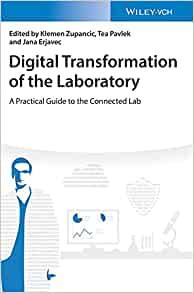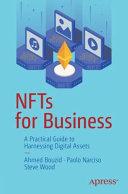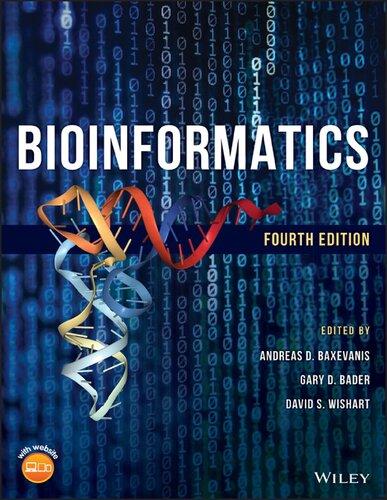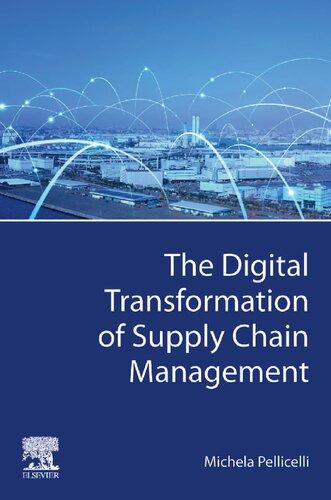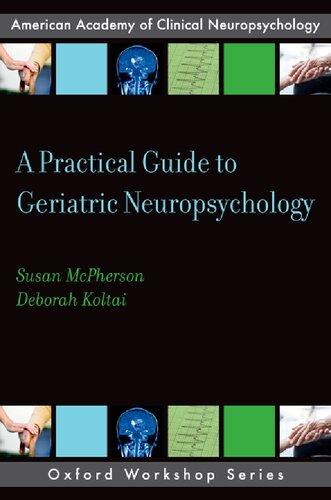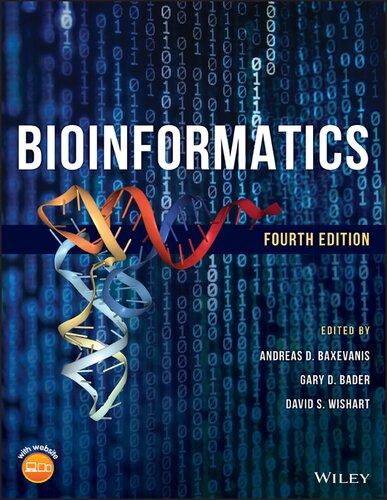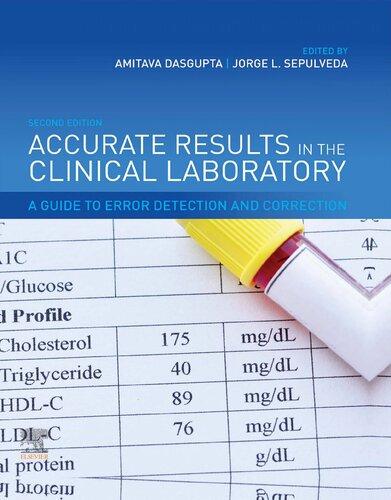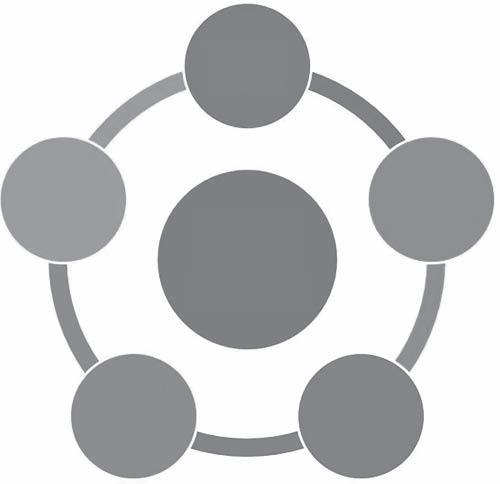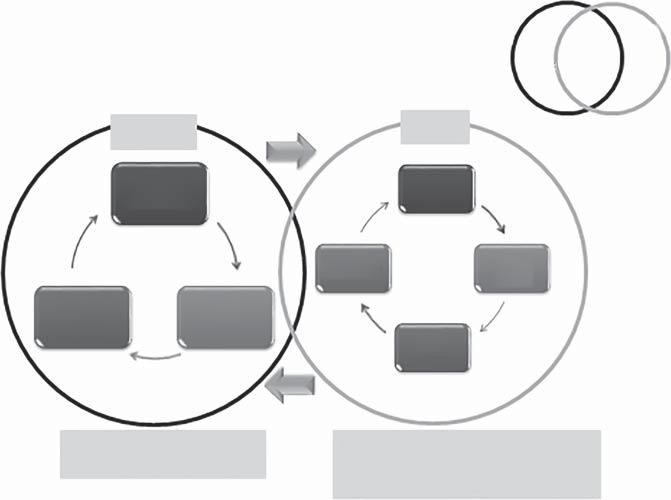Visit to download the full and correct content document: https://ebookmass.com/product/digital-transformation-of-the-laboratory-a-practical-gui de-to-the-connected-lab-klemen-zupancic/
More products digital (pdf, epub, mobi) instant download maybe you interests ...
NFTs for Business: A Practical Guide to Harnessing Digital Assets 1st Edition Ahmed Bouzid
https://ebookmass.com/product/nfts-for-business-a-practicalguide-to-harnessing-digital-assets-1st-edition-ahmed-bouzid/
Bioinformatics: A Practical Guide to the Analysis of Genes and Proteins 4th Edition Andreas D. Baxevanis
https://ebookmass.com/product/bioinformatics-a-practical-guideto-the-analysis-of-genes-and-proteins-4th-edition-andreas-dbaxevanis-2/
The Digital Transformation of Supply Chain Management Michela Pellicelli
https://ebookmass.com/product/the-digital-transformation-ofsupply-chain-management-michela-pellicelli/
Representing the Accused: A Practical Guide to Criminal Defense (Ebook PDF)
https://ebookmass.com/product/representing-the-accused-apractical-guide-to-criminal-defense-ebook-pdf/
A Practical Guide to Geriatric Neuropsychology Susan Mcpherson
https://ebookmass.com/product/a-practical-guide-to-geriatricneuropsychology-susan-mcpherson/
The Absolute Beginner's Guide to HTML and CSS: A Stepby-Step Guide with Examples and Lab Exercises 1st Edition Kevin Wilson
https://ebookmass.com/product/the-absolute-beginners-guide-tohtml-and-css-a-step-by-step-guide-with-examples-and-labexercises-1st-edition-kevin-wilson/
High Frequency Trading with C++: A Practical Guide to Dominating the Markets Bisette
https://ebookmass.com/product/high-frequency-trading-with-c-apractical-guide-to-dominating-the-markets-bisette/
Bioinformatics: A Practical Guide to the Analysis of Genes and Proteins 4th Edition Andreas D. Baxevanis
https://ebookmass.com/product/bioinformatics-a-practical-guideto-the-analysis-of-genes-and-proteins-4th-edition-andreas-dbaxevanis/
Accurate Results in the Clinical Laboratory: A Guide to Error Detection and Correction 2nd Edition Ph.D. Dasgupta
https://ebookmass.com/product/accurate-results-in-the-clinicallaboratory-a-guide-to-error-detection-and-correction-2nd-editionph-d-dasgupta/
APracticalGuidetotheConnectedLab
Editedby KlemenZupancic TeaPavlek JanaErjavec
TheEditors
KlemenZupancic
SciNoteLLC
3000ParmenterSt. 53562MiddletonWI UnitedStates
TeaPavlek
SciNoteLLC
3000ParmenterSt. 53562MiddletonWI UnitedStates
JanaErjavec BioSistemikaLLC Koprskaulica98 1000Ljubljana Slovenia
CoverImage: TeaPavlek
Allbookspublishedby WILEY-VCH arecarefullyproduced.Nevertheless, authors,editors,andpublisherdonot warranttheinformationcontainedin thesebooks,includingthisbook,to befreeoferrors.Readersareadvised tokeepinmindthatstatements,data, illustrations,proceduraldetailsorother itemsmayinadvertentlybeinaccurate.
LibraryofCongressCardNo.: appliedfor
BritishLibraryCataloguing-in-Publication Data
Acataloguerecordforthisbookis availablefromtheBritishLibrary.
Bibliographicinformationpublishedby theDeutscheNationalbibliothek TheDeutscheNationalbibliotheklists thispublicationintheDeutsche Nationalbibliografie;detailed bibliographicdataareavailableonthe Internetat <http://dnb.d-nb.de>
©2021WILEY-VCHGmbH,Boschstr. 12,69469Weinheim,Germany
Allrightsreserved(includingthoseof translationintootherlanguages).No partofthisbookmaybereproducedin anyform–byphotoprinting, microfilm,oranyothermeans–nor transmittedortranslatedintoa machinelanguagewithoutwritten permissionfromthepublishers. Registerednames,trademarks,etc. usedinthisbook,evenwhennot specificallymarkedassuch,arenotto beconsideredunprotectedbylaw.
PrintISBN: 978-3-527-34719-3
ePDFISBN: 978-3-527-82505-9
ePubISBN: 978-3-527-82506-6
oBookISBN: 978-3-527-82504-2
Typesetting SPiGlobal,Chennai,India PrintingandBinding
Printedonacid-freepaper 10987654321
Contents
Preface xvii
PartIInspiration 1
1TheNextBigDevelopments–TheLaboftheFuture 3 RichardShuteandNickLynch
1.1Introduction 3
1.2Discussion 3
1.2.1People/Culture 4
1.2.2Process 5
1.2.3LabEnvironmentandDesign 6
1.2.4DataManagementandthe“RealAsset” 7
1.2.4.1DataintheHypothesis-driven,ResearchLab 7
1.2.4.2DataintheProtocol-drivenLab 8
1.2.4.3NewDataManagementDevelopments 9
1.2.5NewTechnology 11
1.2.5.1LabAutomationIntegrationandInteroperability 12
1.2.5.2QuantumComputingandtheLaboftheFuture 16
1.2.5.3ImpactofAIandML 18
1.2.6NewScience 19
1.2.6.1NewScienceinHealthCare 19
1.2.6.2NewScienceintheLifeSciencesDomain 20
1.2.6.3OtherImportantNewScienceAreas 21
1.3ThoughtsonLotFImplementation 22
1.4Conclusion 22 References 24
PartIIKnowledgeBase 33
2CrucialSoftware-relatedTermstoUnderstand 35 LukaMurn
2.1DigitalRevolution 35
2.2Computers 35
2.2.1Programs,Instructions,andProgrammingLanguages 37
2.2.2HardwareandSoftware 38
2.2.3OperatingSystems 38
2.2.4Abstraction 40
2.2.5Virtualization 40
2.3Internet 41
2.3.1WorldWideWeb(WWW) 42
2.3.2WebApplications 43
2.3.3WebApplicationsinComparisonWithTraditionalApplications 44
2.4CloudComputing 47
2.4.1ClassificationofCloudServices 48
2.4.1.1IaaS(infrastructureasaservice) 49
2.4.1.2PaaS(platformasaservice) 49
2.4.1.3SaaS(softwareasaservice) 49
2.4.2CloudDeploymentModels 50
2.4.2.1PublicCloud 50
2.4.2.2PrivateCloud 51
2.4.2.3HybridCloud 51
2.4.3IssuesandConsiderations 51
2.5ComputerPlatforms 52
2.5.1Desktop/Laptop/PC 53
2.5.1.1DesktopApplications 53
2.5.2Mobile 54
2.5.2.1MobileApplications 55
2.5.3Server/Web 55
2.5.3.1WebBrowser 56
2.5.4Embedded 56
2.5.5Cross-platform 56
2.6Applications 57
2.7ValuesofSoftware 58
2.7.1Features 58
2.7.2Design 58
2.8SoftwareDevelopment 58
2.9SoftwareProductLifecycle 59
2.10SoftwareDesign 61
2.10.1Code 61
2.10.2Data 63
2.11SoftwareQuality 64
2.12SoftwareIntegration 65
2.12.1API 66
2.12.2Middleware 67
2.12.3AuthenticationandAuthorization 67
2.12.4InternetofThings 67
2.13Data-flowModelingforLaboratories 67
2.14SoftwareLicensing 70
2.14.1ProprietarySoftwareLicenses 70
2.14.2OpenSource 70 References 72
3IntroductiontoLaboratorySoftwareSolutionsandDifferences BetweenThem 75 TilenKranjc
3.1Introduction 75
3.2TypesofSoftwareUsedinLaboratories 76
3.2.1ElectronicLabNotebook(ELN) 76
3.2.2LaboratoryInformationManagementSystem(LIMS) 78
3.2.3LaboratoryExecutionSystem(LES) 80
3.2.4LaboratoryDataManagementSystem(LDMS) 80
3.2.5ChromatographyDataManagementSystem(CDMS) 80
3.2.6ProcessAnalyticalTechnology(PAT)Software 81
3.2.7AutomationSchedulingSoftware 82
3.2.8LaboratoryInstrumentSoftware 82
3.2.9MiddlewareandRoboticProcessAutomation(RPA) 83
3.2.10DataAnalysisSoftware 83
3.2.11EnterpriseResourcePlanning(ERP) 84 References 84
4DataSafetyandCybersecurity 85 LukaMurn
4.1Introduction 85
4.1.1MagneticStorage 85
4.1.2Solid-stateDrives 86
4.2DataSafety 86
4.2.1Risks 86
4.2.2Measures 87
4.2.2.1Backups 87
4.2.2.2DataReplication 88
4.3Cybersecurity 88
4.3.1ThreatModel 89
4.3.1.1Untargeted/OpportunisticAttacks 89
4.3.1.2TargetedAttacks 90
4.3.2Risks 90
4.3.2.1PhysicalAccess 91
4.3.2.2SoftwareAccess 91
4.3.2.3PrivilegedUsers 93
4.3.2.4DatainTransit 93
4.3.2.5SocialEngineering 94
4.3.3Measures 96
4.3.3.1PhysicalProtection 96
4.3.3.2SoftwareandInfrastructuralMeasures 96
4.3.3.3Encryption 97
4.3.3.4PoliciesandProcesses 99
4.3.3.5Education 99
4.3.3.6Third-partySecurityReview 100 References 100
5FAIRPrinciplesandWhyTheyMatter 101
KeithRussell
5.1Introduction 101
5.2WhatIstheValueofMakingDataFAIR? 101
5.3ConsiderationsinCreatingLab-basedDatatoPrepareforIttoBe FAIR 102
5.4TheFAIRGuidingPrinciplesOverview 104 References 104
6TheArtofWritingandSharingMethodsintheDigital Environment 107 LennyTeytelmanandEmmaGanley
6.1Introduction 107
6.2ToolsandResourcesforTracking,Developing,Sharing,and DisseminatingProtocols 109
6.2.1ToolsforOrganizingandTrackingYourProtocols 109
6.3MakingYourProtocolsPublic 110
6.4TheArtofWritingMethods 111 References 113
PartIIIPractical 115
7HowtoApproachtheDigitalTransformation 117 JanaErjavec,MatjažHren,andTilenKranjc
7.1Introduction 117
7.2DefiningtheRequirementsforYourLab 118
7.2.1DigitizationVersusDigitalizationVersusDigitalTransformation 118
7.2.2DefiningtheApproachandScopeforYourLab–Digitization, Digitalization,orDigitalTransformation? 119
7.2.2.1WhichChallengesDoIHaveNow? 120
7.2.2.2WhichChallengesNeedMyImmediateAttention? 121
7.2.2.3WhichChallengesDoISeeintheFuture? 121
7.2.2.4WhatisMyLong-termBusinessStrategy? 122
7.2.2.5HowWillChangesAffectMyCurrentBusiness? 122
7.2.2.6HowWillIManageLegacyData? 123
7.2.2.7HowWillIGetPeopletoCooperate? 124
7.3EvaluatingtheCurrentStateintheLab 124
7.3.1DefiningtheOverallGoalsoftheDigitalizedLaboratory 124
7.3.1.1Example 124
7.3.2DefiningtheDataFlows 125
7.3.3DescribingtheProcesses 127
7.3.4IdentifyingtheBottlenecks 128
7.3.4.1BottlenecksinDataFlowOptimization 128
7.3.4.2EfficiencyandIntegrityofDataFlows 128
7.3.4.3Example:MakeDataMachineReadable 129
7.3.5OpportunitiesinProcessOptimization 130
7.3.5.1Time-consumingProcesses 130
7.3.5.2GeneralLaboratoryProcesses 131
7.3.6GapAnalysis 131
7.3.6.1Example 132 References 133
8UnderstandingStandards,Regulations,andGuidelines 135 MatjažHren
8.1Introduction 135
8.2TheNeedforStandardsandGuidelines 136
8.3HowDoesDigitalizationRelatetoStandardsandGuidelines 137
8.3.1StandardsShouldAffecttheSelectionoftheToolsforDigitalization 137
8.3.2DigitalToolsPromoteGoodPractices 138
8.4ChallengesRelatedtoDigitalizationinCertifiedLaboratories 140
8.5CanDigitalStrategybeImplementedwithoutCertification? 141 References 142
9InteroperabilityStandards 143 SörenHohmann
9.1SiLA 144
9.2AnIML 145
9.3Allotrope 146
9.4Conclusion 147
10AddressingtheUserAdoptionChallenge 149 JanaErjavec
10.1Introduction 149
10.2IdentifyKeyStakeholdersandExplaintheReasonsforChange 151
10.3EstablishaSteeringCommittee 152
10.4DefinetheProjectObjectives,ExpectedBehaviour,andTimeline 153
10.5CheckforUnderstandingandEncourageDebate 154
x Contents
10.6AcknowledgeIdeasandCommunicateProgress 155
10.7ProvideaFeedbackMechanism 155
10.8SetUpKeyExperienceIndicatorsandMonitorProgress 156
10.8.1Happiness 156
10.8.2Engagement 157
10.8.3Adoption 157
10.9GraduallyExpandtoaLargerScale 158
10.10Conclusions 159 References 160
11TestingtheElectronicLabNotebookandSettingUpaProduct Trial 161 BlazkaOrel
11.1Introduction 161
11.2TheProductTrial 161
11.3TheImportanceofaProductTrial 162
11.4SettingUpaProductTrial 163
11.4.1PhaseI:Planning 163
11.4.2PhaseII:Conceptualization 164
11.4.3PhaseIII:Testing 166
11.4.4PhaseIV:Reporting 170
11.5GoodPracticesofTestingaProduct 171
11.5.1TakingtheTimeforPlanning 172
11.5.2HavingaBiggerPictureinMind 172
11.5.3KeepingYourTestersMotivated 173
11.5.4SystematicEvaluationofProducts 173
11.5.5CooperatingwithVendors 174
11.6Conclusions 174 References 175
PartIVCaseStudies 177
12UnderstandingandDefiningtheAcademicChemical Laboratory’sRequirements:ApproachandScopeof DigitalizationNeeded 179 SamanthaKanza
12.1TypesofChemistryLaboratory 179
12.2DifferentStagesofDigitalization 179
12.3PreparatoryStage 180
12.3.1DigitalizationRequirements 181
12.3.2IssuesandBarrierstoAdoption 181
12.3.3SuggestedSolutions 181
12.4LaboratoryStage 182
12.4.1DigitalizationRequirements 182
12.4.2IssuesandBarrierstoAdoption 183
12.4.3SuggestedSolutions 184
12.5TransferalStage 185
12.5.1DigitalizationRequirements 185
12.5.2IssuesandBarrierstoAdoption 185
12.5.3SuggestedSolutions 186
12.6Write-upStage 186
12.6.1DigitalizationRequirements 186
12.6.2IssuesandBarrierstoAdoption 187
12.6.3SuggestedSolutions 187
12.7ConclusionsandFinalConsiderations 188 References 189
13GuidelinesforChemistryLabsLookingtoGoDigital 191 SamanthaKanza
13.1UnderstandingtheCurrentSetup 191
13.2UnderstandingYourScientistsandTheirNeeds 192
13.3UnderstandingUser-basedTechnologyAdoption 193
13.4BreakingDowntheBarriersBetweenScienceandTechnology 195
13.5MakingYourLaboratoryTeamUnderstandWhyThisIsNecessary 195
13.6WorkingwithDomainExperts 195
13.7ChoosingtheRightSoftware 196
13.8ChangingAttitudeandOrganization 196 References 197
14ElectronicLabNotebookImplementationinaDiagnostics Company 199 CaseyScott-Weathers
14.1MakingtheDecision 199
14.2ProblemswithPaperNotebooks 199
14.3DeterminingLaboratory’sNeeds 200
14.4Testing 201
14.5ADecision 201
14.6HowtoStructuretheELN 202
14.7Conclusion 203
15IdentifyingandOvercomingDigitalizationChallengesina Fast-growingResearchLaboratory 205 DorotheaHöpfner
15.1WhyGoingDigital? 205
15.2StepstoIntroduceELNsinLabPractice 207
15.2.1Step1:GettingtoKnowtheMarketorWhatWeCanExpectofan ELN 207
15.2.2Step2:DefiningtheNeedsofOurLabandOurRequirementsforan ELN 208
15.2.2.1DataStructure 209
15.2.2.2CompatibilitywithDatabases 209
15.2.2.3FlexibilityofDocumentationStyle 209
15.2.2.4ReportOptions 210
15.2.2.5Speed 210
15.2.3Step3:MatchingSteps1and2andTestingOurBestOptions 210
15.2.4Step4:GettingStartedinImplementingtheELN 211
15.3CreatingtheMindsetofaDigitalScientist 213
15.4TheDilemmaofDigitalizationinAcademia 214
16TurningPaperHabitsintoDigitalProficiency 217 TessaGrabinski
16.1FiveMainReasonsfortheImplementationofaDigitalSystemto ManagetheResearchData 217
16.1.1Scale-upoftheLaboratory 218
16.1.2ProtocolManagementIssues 218
16.1.3EnvironmentalandFinancialFactors 218
16.1.4IntroducingtheBenefitsofTechnologytoYoungerEmployees 219
16.1.5RemoteAccesstoDatabyAuthorizedSupervisors 219
16.2TheSix-stepProcessofGoingfromPapertoDigital 219
16.2.1DefiningtheSpecificNeedsoftheLaboratory 219
16.2.2TestingtheSoftwareandDefiningtheStandardWaytoUseIt 220
16.2.3OrganizingtheCollaborationBetweenLabMembersand Supervisors 221
16.2.4ManagingProjectsandSettingUpWorkProcesses 222
16.2.5VersioningofProtocolsandKeepingtheProtocolRepositoryUpto Date 225
16.2.6ChoosingtoDigitizeOnlyNewProjects 226
16.3OnboardingAllTeamMembersandEnhancingtheAdoptionoftheNew TechnologyintheLab 226
16.4BenefitsofSwitchingfromPapertoDigital 230
17GoingfromPapertoDigital:StepwiseApproachbythe NationalInstituteofChemistry(ContractResearch) 231 SamoAndrensekandSimonaL.Hartl
17.1PresentationofourCVTALaboratory 231
17.2DataManagementRequirementsExplainedinDetail 231
17.2.1MeaningofALCOA 232
17.2.2FDAandCFR21Part11 233
17.2.3MHRAandGxPDataIntegrityGuidanceandDefinitions 233
17.2.4DefinitionofTermsandInterpretationofRequirements 235
17.3GoingfromPapertoDigital 240
17.4ImplementationofSciNote(ELN)toCVTASystem 241
17.4.1SomeofCVTAuser’sRequirements(URS) 242
17.4.2FromDocumentationReviewandApprovaltoELN Implementation 242
17.4.3Step-by-StepImplementationofChangeControlManagementin SciNote 244
17.4.3.1CreatingProjectsinSciNote 245
17.4.3.2CreatingaWorkflow 245
17.4.3.3CreatingtheTasksandProtocolSteps 245
17.4.3.4Filtering,OverviewofDataandInventoryforChangeControl Management 246
17.4.3.5AuditTrailofChanges 246
17.4.3.6OverviewofallActivities 246
17.4.4OrganizationandSigningofCVTADocumentationinELNSciNoteDue toUserRolesandPermissions 250
17.4.4.1ManagingtheTeamRolesandResponsibilitieswithinSciNote 250
17.4.4.2ManagingProjectsforEfficientWorkwithClients 250
17.5SuggestionsforImprovementsandVisionfortheFuture 251 References 251
18WetLabGoesVirtual:InSilicoTools,ELNs,andBigDataHelp ScientistsGenerateandAnalyzeWet-labData 253 JungjoonLeeandYoonjooChoi
18.1CRISPR-Cas9Explained 254
18.2IntroductionoftheDigitalSolutionsandELNintotheLaboratory 255
18.3TheRoleoftheELNandInSilicoToolsintheGenome-editing Process 255
18.3.1DesigningsgRNA 255
18.3.2IssueswithPaper-basedProcessesandtheUseofELN 256
18.3.3High-contentImagingfortheTargetDiscovery 256
18.3.4PlantVirtualLaboratory 257
18.4TheRoleoftheELNandInSilicoToolsintheProteinDesign Process 258
18.4.1ProteinModeling 258
18.4.2ProteinRedesign 259
18.4.3ImportanceofKeepingtheElectronicRecords 260
18.4.4DevelopmentofTherapeuticAntibodies 260
18.4.5ImportanceofElectronicLabNotebookforCommunicationBetween TeamMembers 262 References 263
19DigitalLabStrategy:EnterpriseApproach 265 CesarTavares
19.1Motivation 265
19.1.1WhichProblemDoWeWanttoSolve? 265
19.1.2NewProblemsRequireNewAnswers 266
19.2DesigningaFlexibleandAdaptableArchitecture 267
19.3ThereisOnlyOneRule:NoRules 269
19.4TheLabDigitalizationProgramCompass 270
19.5Conclusion 273 References 273
PartVContinuousImprovement 275
20NextSteps–ContinuityAfterGoingDigital 277 KlemenZupancic
20.1AreYouReadytoUpgradeFurther? 277
20.2UnderstandingtheBigPicture 277
20.3WhattoIntegrateFirst? 279
20.3.1Integrations 280
20.3.2LaboratoryEquipment–ConceptsofIoTandLab4.0 281
20.3.2.1DoestheEquipmentSupportIntegrations? 281
20.3.2.2HowOftenIstheInstrumentBeingUsed? 282
20.3.2.3IsThereaHighChanceforHumanError? 282
20.3.2.4DoYouNeedOne-orTwo-waySync? 282
20.3.2.5IstheEquipmentUsingAnyStandards? 282
20.3.2.6IsEquipmentCloudConnected? 282
20.3.3DataRepositories 282
20.3.4DataAnalyticsTools 283
20.3.5OtherTypesofIntegrations 284
20.3.5.1ScientificSearchEnginesandLiteratureManagement 284
20.3.5.2DataSharing 284
20.3.5.3Publishing 285
20.3.5.4UpgradingPlans 285
20.4Budgeting 285
20.5ContinuousImprovementasaValue 286 References 286
PartVIVisionoftheFutureandChangingtheWayWeDo Science 287
21ArtificialIntelligence(AI)TransformingLaboratories 289 DunjaMladenic
21.1IntroductiontoAI 289
21.1.1Opportunities 289
21.1.2Needs 290
21.1.3Challenges 290
21.2ArtificialIntelligenceinLaboratories 291
21.2.1DataPreprocessing 291
21.2.2DataAnalytics 292
21.3ProcessMonitoring 293
21.4Discussion–HumanintheLoop 294 References 295
22Academic’sPerspectiveontheVisionAbouttheTechnology TrendsintheNext5–10Years 297 SamanthaKanza
22.1HybridSolutions 297
22.2VoiceTechnologies 298
22.3SmartAssistants 298
22.4InternetofThings 298
22.5RobotScientists 299
22.6MakingScienceSmart–IncorporatingSemanticsandAIintoScientific Software 300
22.7Conclusions 300 References 301
23LookingtotheFuture:AcademicFreedomVersusInnovation inAcademicResearchInstitutions 303 AlastairDownie
23.1Introduction 303
23.2CorporateCultureVersusAcademicFreedom 303
23.3SpoiledforChoice,butStillWaitingforthePerfectSolution 304
23.4BuildingaSingle,SharedInfrastructureforResearchData Management 305
23.5AJourneyofaThousandMilesBeginswithaSingleStep 307 Reference 308
24FutureofScientificFindings:Communicationand CollaborationintheYearstoCome 309 LennyTeytelmanandEmmaGanley
24.1Preprints:ReversingtheIncreasedTimetoPublish 309
24.2VirtualCommunities 310
24.3EvolvingPublishingModels 312
24.4FundersAreStartingtoPlayaRoleinFacilitatingandEncouraging RapidSharingandCollaboration 312
24.5Conclusion 314 References 314
25Entrepreneur’sPerspectiveonLaboratoriesin10Years 317 TilenKranjc
25.1DataRecording 317
25.2RecognitionofVoiceandWriting 318
25.3DataRecordingintheFuture 318
25.4ExperimentalProcesses 318
25.5ResearchProjectManagement 319
25.6ExperimentalPlanning 319
25.7VirtualReality 320
25.8SmartFurniture 320
25.9ExperimentExecution 321
25.10LaboratoryAutomationTrends 321
25.11CloudLaboratories 322
25.12DataAnalysisTrends 323
25.13ArtificialIntelligence 324
25.14DataVisualizationsandInterpretation 325
25.15Databases 325
25.16Conclusion 326 References 326
Index 329
Preface
Thesubjectofdigitaltransformationisactuallyaboutyou. Yourscience,youreverydayworkenvironment,yourpartnershipsandcollaborations,andtheimpactofyourworkonthefutureofscientificprogress. Welcometothisbook.
Asabrilliantastronomer,MariaMitchelloncesaid,“minglethestarlightwith yourlivesandyouwon’tbefrettedbytrifles.”
Thegreatermeaningofdigitaltransformationshiftstheperspectivetowardthe globalschemeofthings.Themainevaluatingfactorsbehindthelabdigitalization anddigitaltransformationanswerimportantquestions:Areweimprovingthequality,efficiency,andthepaceofinnovation?
Labdigitalizationisapeople-driveninitiativethataimstoaddresstheglobalchallengesandprovidesolutions,backedbyunquestionableintegrityoftraceableand reproduciblescientificdata.
Atthemoment,regardlessofthelaboratorytypeorsize,peoplearestruggling withthegrowingamountofgenerateddataandleveragingitsvalue.Itisextremely challengingtoorganizedataandkeepeverythingtraceableandreusablelongterm.
Toaddressthechallenge,modularityandflexibilityarebeingincorporatedon differentlevelsoflaboperations.Labsarebecominginvitingspacessuitablefor interdisciplinarypartnershipsinadigital,virtual,orpersonalenvironment.Data integrityinitiativesandsetupofnew,digitalsystemsprioritizeintegrationofalltech solutionsusedinthelabforoptimalperformance.Througheffectiveintegration oftools,improvedscientist-to-scientistinteractionsandintellectualcontributions, andqualitychangemanagement,labdigitalizationplacesthehumanelementat theveryforefrontoftheoverallprogresstowardthedigitalfuture.
Thiscanbeintimidatingtosomeandexhilaratingtoothers.
Thatiswhythisbookisdividedintomodules:Inspiration,KnowledgeBase,Practical,CaseStudies,ContinuousImprovement,andVisionoftheFuture.Eachmodulecoversdifferentaspectsoflabdigitalization.
Inspiration
Westartthisbookwithaninspiringoverviewoflabevolution,newtechnologies, andnewsciencebeingdone.Itwillgiveyouacompleteoverviewofthesubjectof
laboratoriesofthefutureand,hopefully,addtothevisionofyourowncareerin scienceandtechnology.
KnowledgeBase
KnowledgeBasesectionfocusesoncrucialtermstounderstand.Itwillgiveyoua solidbasisofknowledgethatyouwillbeabletoapplyfurtheronasyourlabgrows andevolves.
Practical
ThePracticalchaptersgiveyouexamplesandguidanceondefiningyourlab’sdigitalizationstrategy.
CaseStudies
Wepresentdifferentcasestudiesandexpertcommentsonthesubjectofgoingfrom papertodigital.Youwillbeabletoreadhowdifferentlaboratoriesandprofessionalsapproachedthesubjectandputitintopractice,andwhataretheirconclusions, advice,andlessonslearned.
ContinuousImprovement
Wehaveacloserlookatthestepsthatfollowafterthedigitalization.
VisionoftheFutureandChangingtheWayWeDoScience
Withcontinuousimprovementsinmind,weconcludethebookwithinsightful expertcommentsonthesubjectofthefutureofscience.Manyofthedescribed technologiesarealreadybecomingimportant,andhereweidentifythosethatmight shapethenext5–10yearsandchangethewaywedoscience.
Asyoureadthisbook,youwillgainholisticknowledgeondigitaltransformation ofthelaboratory.Tracking,analyzing,andleveragingthevalueofdatayouarecollecting,byimplementingtoolsthatcanempowerthepeopleinyourlab,arethemain pointsofthisjourney.
Usingtheknowledge,youwillbeabletostartdefiningwhatexactlyyouwantto achieve.Onceyouclarifyyourmaingoals,youwillbeabletogoallthewayback throughtheprocessesinyourlabandseewhichneedtobedigitalized.
Preface xix
Thatiswhenyouwillgettherealincentivetodoit.
Youwillunderstandwhetheryouaretryingtojustusetechnologyasaconveniencetosupportthesystemyoualreadyhave,orareyoureadytothinkaboutusing thebettertechnologytochangeandimprovethesystem.
Youwillrealizewhatkindofdecisionsyouneedtomakethroughoutthecycle. Selectingtherightdigitalsolutionsisquiteachallenge.Itisimportanttothink howthepotentialsolutionswillfitintoyourexistingarchitecture.Aninvestment oftime,energy,andbudgetisalwaysinvolved,especiallyifthesolutionsarenot integratedproperlyoryourteamisnotinsync.
Theknowledgeyouwillgainwillenableyoutomeasureandevaluatetheimpact ofdigitalization.Howwilltheuseofparticulartoolsimprovespecificpartsofyour processestoreachyourgoalswithinthegiventimeframes?
Keepingtherazor-sharpfocusanddeterminationisthemostpotentdriverofdigitalization.
Allsolutionswork,buttheexecutioniscrucial.Youwilllearnhowtotakean agileapproach,definethevalueforyourteam,startsmall,andscaleupefficiently andsuccessfully.
Thisbookisaresultofcollaborationbetweendifferentauthors–researchers, businessowners,consultants,managers,andprofessorswhowroteabouttheirvast experienceandprovidedvaluableperspectiveonthesubjectofdigitaltransformation.Becauseeverylabisdifferent,andthereareasmanyusecasesastherearelabs, ouraimwastointroduceyoutoadigitalmindsetthatwillenableyoutofindthe bestsolutionforyourlab.
Thisbookguidesyouthroughtheaspectsoftakingyourtimetounderstandthe basicsoftechnology,adaptthedigitalmindset,includeyourteamandaddresstheir concernsandchallenges,readhowotherlabsstartedtopavetheirdigitalway,and stayinspiredalongtheway.
Let’sdivein.
PartI
Inspiration
Westartthisbookwithaninspiringoverviewoflabevolution,newtechnologies, andnewsciencebeingdone.Itwillgiveyouacompleteoverviewofthesubjectof laboratoriesofthefutureand,hopefully,addtothevisionandpurposeofyourown careerinscienceandtechnology.
TheNextBigDevelopments–TheLaboftheFuture
RichardShuteandNickLynch
CurlewResearch,WoburnSands,UK
1.1Introduction
SteveJobsoncesaidthat“thebiggestinnovationsofthe21stcenturywillbeatthe intersectionofbiologyandtechnology”;inthis(r)evolution,thelabwillmostdefinitelyplayakeyrole.
WhenspeculatingonthefuturedigitaltransformationofthelifesciencesR&D, onemustconsiderhowthewholelabenvironmentandthesciencethatgoesonin thatlabwillinevitablyevolveandchange[1,2].ItisunlikelythatanR&Dlabin 2030,andcertainlyin2040,willlookandfeellikeacomparablelabfrom2020.So, whatarethelikelynewbigtechnologiesandprocessesandwaysofworkingthat willmakethatlabofthefuture(LotF)sodifferent?Thissectionendeavorstointroducesomeofthenewdevelopmentsintechnologyandinsciencethatwethinkwill changeandinfluencethelifesciencelabenvironmentovertheupcomingdecade.
1.2Discussion
Beforegoingintothenewtechnologyandscienceindetail,itisimportanttorecognizethatthislabevolutionwillbedrivennotjustbynewtechnologiesandnew science.Inourview,therearefouradditionalbroader,yetfundamentalandcomplementaryattributesthatinfluencehowalabenvironmentchangesovertime.They are:
1.Peopleandcultureconsiderations
2.Processdevelopmentsandoptimization
3.Datamanagementimprovements
4.Labenvironmentanddesign
Whenweaddthefifthmajordriverofchange–newtechnology(includingnew science)–itbecomesclearthatdigitaltransformationisacomplex,multivariate concept(Figure1.1).
DigitalTransformationoftheLaboratory:APracticalGuidetotheConnectedLab, FirstEdition. EditedbyKlemenZupancic,TeaPavlekandJanaErjavec. ©2021WILEY-VCHGmbH.Published2021byWILEY-VCHGmbH.
Figure1.1 Complex,multivariateconceptoflabtransformation.
Inthissection,wediscusshoweachofthesehigh-levelattributeswillinfluence thechanginglabandtheexpectationsoftheusers.Forallfiveareas,weinclude whatwethinkaresomeofthemostimportantaspects,whichwebelievewillhave themostimpactonthe“LotF.”
1.2.1People/Culture
TheLotFandthepeoplewhoworkinitwillundoubtedlybeoperatinginan R&Dworldwherethereisanevengreateremphasisonglobalworkingand cross-organizationcollaboration.Modernscienceisalsobecomingmoresocial [3],andthemostproductiveandsuccessfulresearcherswillbefamiliarwiththe substanceandthemethodsofeachother’sworksobreakingdownevenmorethe barrierstocollaboration.Thesecollaborativeapproacheswillfosterandencourage individuals’capacitytoadoptnewresearchmethodsastheybecomeavailable;we sawthiswiththefastuptakeofclusteredregularlyinterspacedshortpalindromic repeat(CRISPR)technology[4].“Openscience”[5]willgrowevermoreimportant todrivescientificdiscovery.Thiswillbeenabledthroughtheincreaseduseof newcryptographicDistributedLedgerTechnology(DLT)[6],whichwillmassively reducetheriskofIPbeingcompromised[7].TheLotFwillalsoenablemore open,productive,collaborativeworkingthroughvastlyimprovedcommunication technology(5Gmovingto6G)[8].Thepeopleworkingintheselabswillhavea muchmoreopenattitude,culture,andmindset,giventheinfluenceoftechnology suchassmartphonesontheirpersonallives.
People
Process
Digital transformation
Data
4. Lab environment
5. New tech and science
1.2Discussion 5
Roboticsandautomationwillbeubiquitous,butwithmoreautomatedassistance, thedensityofpeopleinthelabwilllikelydrop,allowingscientiststofocusonkey aspectsandcomplexpartsoftheexperiments.Asaconsequence,issuesaround safetyand“loneworking”willgrow,andafocusontheinteractionpointswhichscientistshavewithautomationwilldeveloptoensuretheyareproperlyprotected.For thefewremaininglabtechnicians,notonlywillsafeworkingbecomeofincreased importance,buttheneedfororganizationstodeliverabetter“userexperience”(UX) intheirlabswillbecomekeytohelpthembothattractthesmallernumbersofmore experttechniciansandalsoretainthem.Thelabtechnician’sUXwillbemassively boostedbymanyofthenewtechnologiesalreadystartingtoappearinthemore future-lookinglabs,e.g.voicerecognition,augmentedreality(AR),immersivelab experience,amoreintelligentlabenvironment,andothers(seelatersections).
1.2.2Process
Thelabprocesses,or“how”sciencegetsdoneintheLotF,willbedominatedby roboticsandautomation.Buttherewillbeanotherstrongdriverwhichwillforce labprocessesandmindsetstobedifferentin5–10yearstime:sustainability.Experimentswillhavetobedesignedtominimizetheexcessiveuseof“noxious”materials(e.g.chemicalandbiological)throughouttheprocessandinthecleanuponce theexperimentiscomplete.Similarly,theuseof“bad-for-the-planet”plastics(e.g. 96/384/1536-wellplates)willdiminish.Newprocessesandtechniqueswillhaveto beconceivedtocircumventwhatarestandardwaysofworkinginthelabof2020. Insupportofthesustainabilitydriver,miniaturizationoflabprocesseswillgrow hugelyinimportance,especiallyinresearch,diagnostic,andtestinglabs.Thecurrentso-calledlabonachipmovementhasmanyexamplesofprocessminiaturization [9].Laboratoriesandplantsthatarefocusedonmanufacturingwillcontinuetowork atscale,buttheongoingsearchformoreenvironmentallyconsciousmethodswill continue,includingclimate-friendlysolvents,reagents,andtheuseofcatalystswill growevermoreimportant[10].Therewillalsobeagreaterfocusonbetterplant design.Forexample,3Dprinting[11]couldallowforlocalizationofmanufacturing processesneartothepointofusage.
Inthepreviousparagraph,wereferto“research,diagnostic,andtestinglabs” andtomanufacturing“plant.”Webelievethereisafundamentaldifference betweenwhatwearecallinghypothesis-andprotocol-drivenlabs,andthisis animportantconsiderationwhenthinkingabouttheLotF.Theformerareseen inpureresearch/discoveryandacademia.Theexperimentsbeingundertakenin theselabsmaybethefirstoftheirkindandwillevolveasthehypothesisevolves. Suchlabswillembracehighthroughputandminiaturization.Protocol-drivenlabs, wherepureresearchisnotthemainfocus,includefacilitiessuchasmanufacturing, diagnostic,analytical,orgene-testinglabs.Thesetendtohavealowerthroughput, thoughtheirlevelsofproductivityaregrowingasautomationandhigherquality processesenableeverhigherthroughput.Intheselabs,reproducibilitycombined withrobustreliabilityiskey.Examplesinthislatterareaincludethegenomic screeningandtestinglabs[12,13],whichhavebeengrowingmassivelyinthe
rich, quick cycles
Figure1.2 Virtualandrealdesign-make-test-analyze(DMTA)concept.
pastfewyears.Fortheselabsthealreadyhighlevelsofautomationwillcontinue togrow.
Inthehypothesis-drivenlab[14]withthestrongdriverofsustainabilitycombinedwiththegrowthofeverhigherqualityartificialintelligence(AI)andinformaticsalgorithms,therewillbemoreinsilico,virtual“design-make-test-analyze” (vDMTA)andless,tangibleMakeandTest(seeFigure1.2).Fewer“real”materials willactuallybemadeandtested,andthosethatarewillbeproducedonamuch smallerscale.
Finally,aslabsgetmoresophisticated–withtheirhighlevelsofautomation, robotics,miniaturization,anddataproduction(butwithfewerstaff)–combined withtheneedforthosefacilitiestobebothsafeandsustainable,theconcept of“laboratoryasaservice”(LaaS)willgrow[15].TheLotFwillnotbeastatic, self-contained,andsinglescientificareafacility.Itwillbeablankcanvas,asitwere, inalargewarehouse-likefacilityorcargocontainer[16]whichcanbeloadedupon demandwiththenecessaryequipment,automation,androboticstodoacontracted pieceoflabwork.Thatpieceofworkmightbeachemicalsynthesisoracell-based pharmacologicalassayoneday,andanexvivosafetyscreeninthesameareathenext day.Thekeywillbeuseofamodulardesignsupportedbyfullyconnecteddevices.
1.2.3LabEnvironmentandDesign
Thelabenvironment,itsdesign,usability,andsustainabilityarementionedpreviouslyinthissectionandelsewhereinthebook,butitisfairtosaythatalllabswill
facethepressure[17,18]todesignsustainablespaces[19]thatcankeepupwithall theemergingtechnicaltrendsaswellastheusabilityanddesignfeaturesneededto supportanewgenerationofscientists.Thesedriverswillcombinetoinfluencehow theLotFevolvesandexperimentsareperformed.Researchinstitutionsarealready creatingmore“open”labsareastosupportinterdisciplinaryteamwork,collaborative working,andjointproblemsolving,ratherthantheprevious“siloed”departmental culture.ThiswillcontinueintheLotF.Thegrowthofinnovationclusters[20]and labcoworkingspaceswillrequiremoreconsiderationastohowsharedautomation andlabequipmentcanbeeffectivelyandsecurelyusedbygroups,whomaybeworkingfordifferentorganizationsandwhowillwanttoensuretheirdataandmethods arestoredandprotectedinthecorrectlocations.EffectiveschedulingwillbecriticalintheLotFtoenablehighproductivityandtoensurethatthehighvalueofthe automationassetsisrealized.
1.2.4DataManagementandthe“RealAsset”
Itistrueof2020,justasitwas50yearsagoandwillbein50yearstime,thatthe primaryoutputofR&D,inwhateverindustry,isdata.Theonlyphysicalitemsofany valueareperhapssomesmallamountsofafewsamples(andsometimesnoteven that)plus,historically,alotofpaper!Itisthereforenotsurprisingthatthememe “dataisthenewoil”[21]hascometosuchprominenceinrecenttimes.Whileit maybeviewedbymanyashackneyed,andbymanymoreasfundamentallyflawed [22],theideacarriesalotofcredenceaswemovetowardamoredata-drivenglobal economy.Oneofthemainflawsarisingfromtheoilanalogyisthelackoforganizationsbeingabletosuitablyrefinedataintotheappropriatenextpieceofthevalue chain,comparedtooil,whichhasaveryclearrefiningprocessandvaluechain.Furthermore,the“KeepitintheGround”[23,24]sustainabilitymomentummakesthe data-oilanalogyperhapsevenlessuseful.However,withintheLotF,andinamore open,collaborativeglobalR&Dworld,experimentaldata,bothrawandrefined,will growincriticality.Withoutdoubt,datawillremainaprimaryassetarisingfrom theLotF.
Atthispointthenitisworthconsideringhowdataanddatamanagementfitinto theprocessesthatdrivethetwofundamentallabtypes,whichwehavereferredto earlier,namely(i)thehypothesis-driven,moreresearch/discovery-drivenlaband (ii)theprotocol-driven,more“manufacturing”-likelab.
1.2.4.1DataintheHypothesis-driven,ResearchLab
Inapureresearch,hypothesis-drivenlab,whetheritisinlifescience,chemical science,orphysicalscience,thereisafundamental,cyclicalprocessoperating.Thisprocessunderpinsallofscientificdiscovery;werefertoitasthe “hypothesis-experiment-analyze-share”(“HEAS”)cycle(seeFigure1.3)or,alternatively,ifoneisinadiscoverychemistrylab,forexampleamedicinalchemistrylab inbiopharma,DMTA(seeFigure1.2).
Theresearchscientistsgeneratetheiridea/hypothesisanddesignanexperimentto testit.Theygatherthematerialstheyneedtorunthatexperiment,whichtheythen
Figure1.3 Hypothesis-experiment-analyze-share(HEAS)cycle.
performinthelab.Allthetimetheycaptureobservationsonwhatishappening. Attheendthey“workup”theirexperiment–continuingtocaptureobservations andrawdata.Theyanalyzetheir“raw”dataandgenerateresults(“refined”data); thesedeterminewhethertheexperimenthassupportedtheirhypothesisornot.They thencommunicatethoseresults,observations,andinsightsmorewidely.Ultimately, theymoveontothenext,follow-onhypothesis;then,itisoffroundthecyclethey goagainuntiltheyreachsomesortofendpointorfinalconclusion.Allthewhile theyaregeneratingdata:rawdataoffinstrumentsandcapturedvisualobservations andrefineddata,whicharemorereadilyinterpretableandcanmoreeasilyleadto insightsandconclusions.
1.2.4.2DataintheProtocol-drivenLab
Intheprotocol-drivenlab,whetheritisinamanufacturingorsampletesting domain,thereisagainafundamentalprocesswhichoperatestodrivethevalue chain.Unlikethe“HEAS”cyclethisismoreofalinearprocess.Itstartswitha requestandendsinacommunicableresultorashippableproduct.Thisprocess, whichwerefertoasthe“request-experiment-analyze-feedback”(REAF)process,is outlinedinFigure1.4.
Therearemanysimilarities,oftenclose,betweenthelinearREAFprocessandthe HEAScycleespeciallyintheExperiment/ObserveandAnalyze/Reportsteps,butthe REAFprocessdoesnotstartwithanideaorhypothesis.REAFrepresentsaservice, whichstartswithaformalrequest,forexampletorunaprotocoltomanufacturea goodortotestasample,andendswithaproductorasetofresults,whichcanbefed backtotheoriginalcustomerorrequester.AswenotedinSection1.2.4.1above,itis increasinglylikelythattheLotFwillbesetupwithaLaboratoryasaService(LaaS) mentality;REAFmaythereforebemuchmorebroadlyrepresentativeofhowlabsof thefuturemightoperate. Request and schedule Experiment and observe
Figure1.4
1.2Discussion 9
Itisimportanttoacknowledgethatthedataandinformation,whichdriveRequest andFeedback,arequitedifferentinREAFthaninthecorrespondingsectionsin HEAS.WiththefocusofthisbookbeingonExperiment/Observe,andtoadegree Analyze,wewillnotsayanythingmoreaboutRequestandFeedback(fromREAF) andHypothesisandShare(fromHEAS).Instead,theremainderofthissection focusesonwhattheExperimentandAnalyzedatamanagementaspectsoftheLotF willlooklike,whetherthatLotFisahypothesis-oraprotocol-drivenlab.Thisis madesimplerbythefactthatintheExperiment/ObserveandAnalyze/Reportsteps, thedatachallengesinthetwodifferentlabtypesare,toallintentsandpurposes, thesame.Intheremainderofthissectionwetreatthemassuch.
1.2.4.3NewDataManagementDevelopments
Sowhatnewdevelopmentsindatamanagementwillbeprevalentinboththe hypothesis-andtheprotocol-drivenlabsof2030?Intheprevioustwosections weassertedthattheselabswillbepopulatedbyfewerpeople;therewillbemore roboticsandautomation,andtheexperimentthroughputwillbemuchhigher, oftenonmoreminiaturizedequipment.Buildingontheseassertionsthen,perhaps themostimpactfuldevelopmentsinthedataspacewillbe:
a)Theallpervasivenessofinternetofthings(IoT)[25,26].Thiswilllead,inthe LotF,tothegrowthoftheinternetoflaboratorythings(IoLT)environments;this willalsobedrivenbyubiquitous5Gcommunicationscapability.
b)Thewidespreadadoptionofthefindable,accessible,interoperable,andreusable (FAIR)dataprinciples.ThesestatethatalldatashouldbeFAIR[27].
c)Thegrowinguseofimprovedexperimentaldataandautomationrepresentation standards,e.g.SiLA[28]andAllotrope[29].
d)Datasecurityanddataprivacy.ThesetwoareaswillcontinuetobecriticalconsiderationsfortheLotF.
e)Theubiquityof“Cloud.”TheLotFwillnotbeabletooperateeffectivelywithout accesstocloudcomputing.
f)Digitaltwinapproaches.Thesewillcomplementboththedrivetowardlabsoperatingmoreasaserviceandthedemandforremoteservicecustomerswantingto seeinto,andtodirectlycontrolfromafarwhatishappeninginthelab.Technologiessuchasaugmentedreality(AR)willalsohelptoenablethis(seeSections 1.2.5and1.2.6).
g)Quantumcomputing[30–33].Thismovesfromresearchtoproductionand soimpactsjustabouteverythingwedoinlife,notjustintheLotF.Arguably, quantumcomputingmighthaveabiggerimpactinthemorecomputationally intensivepartsofthehypothesis-andprotocol-drivenLotF,e.g.Idea/Hypothesis designandAnalyze/Insight,butitwillstilldisrupttheLotFmassively.Wesay moreonthisinSections1.2.5and1.2.6.
Thefirstthreeofthesedevelopmentsareallrelatedtothedrivetoimprovethe speedandqualityofthedata/digitallifecycleandtheoveralldatasupplychain. ThatdigitallifecyclealignscloselytotheHEASandREAFprocessesoutlinedin Figures1.3and1.4andcanbesummarizedasfollows(seeFigure1.5):
Figure1.5 Digitaldatalifecycle.
IoTtechnology[34]willallowmuchbetterconnectivitybetweentheequipment intheLotF.Thiswillenablebetter,quicker,andmoreprecisecontrolofthelabkit, aswellasmoreeffectivecapturingoftherawdataofftheequipment.Thisinturn willallowthenextstageinthelifecycle–“AnalyzeData”–tohappensoonerand withmore,betterqualitydata.Thisimprovedinterconnectednessinthelabwillbe madepossiblebythesame5Gcommunicationtechnologywhichwillbemaking thedevicesandproductsinthehomeof2025morenetworkedandmoreremotely controllable.
AsimprovedinstrumentinterconnectednessandIoLTenablemoredatatobe capturedbymoreinstrumentsmoreeffectively,theissueofhowyoumanagethe inevitabledatafloodtomakethedelugeusefulcomestothefore.Thebiggestinitiativein2020tomaximizethebenefitsoftheso-calledbigdata[35]revolvesaround theFAIRprinciples.Thesestatethat“forthosewishingtoenhancethereusability oftheirdataholdings,”thosedatashouldbeFAIR.IntheLotF,theFAIRprinciples willneedtobefullyembeddedinthelabcultureandoperatingmodel.Implementing FAIR[36]isverymuchachangeprocessratherthanjustintroducingnewtechnology.Iffullyimplemented,though,FAIRwillmakeitmassivelyeasierforthevast quantitiesofdigitalassetsgeneratedbyorganizationstobemademuchmoreuseful.Datascienceasadiscipline,anddatascientists(arolewhichcanbeconsidered currentlytoequatetothatof“informatician”),willgrowenormouslyinimportance andsize/number.Organizationsthatarealmostpurelydatadrivenwillthrive,with anylabworktheyfeeltheneedtodobeingoutsourcedviaLaaS[37]toflexible, cost-effectiveLotFsthatoperatepertheREAFprocess.
SupportingthegrowthofFAIRrequiresthedatathatisgeneratedintheseLaaS LotFstobeeasilytransferablebacktotherequester/customerinaformatwhichthe labcangenerateeasily,accurately,andreproducibly,andwhichthecustomercan importandinterpret,again,easily,accurately,andreproducibly.Thisfacileinterchangeof“interoperable”datawillbeenabledbythewidespreadadoptionofdata standardssuchasSiLAandAllotrope.Wedescribethesenewdatastandardsinmore detailinthefollowingsection.
Twoadditional,significantdataconsiderationsfortheLotFarethoseofdatasecurityanddataprivacy,justastheyarenow.ThemoreLotFservicesthatareoperated outsidethe“firewall”ofanorganization,andthemorethatfuturelabsaredrivenby data,themoreriskspotentiallyarisefromaccidentalormaliciousactivities.Making surethatthoserisksarekeptlow,throughcontinueddiligenceanddatasecurity,will ensurethattheLotFisabletodevelopandoperatetoitsfullcapability.Similarly,in labsthatworkwithhuman-derivedsamples(blood,tissues,etc.),theadventofregulationssuchastheGeneralDataProtectionRegulations(GDPR)[38,39],alongwith
1.2Discussion 11
thehistoricalstringencysurroundinginformedconsent[40]overwhatcanhappen tohumansamplesandthedatathatarisesfromtheirprocessing,willputevenmore pressureontheorganizationsthatgenerateandareaccountableforhumandata toensurethesedataareeffectivelysecured.ImprovedadherencetotheFAIRdata principles,especiallyFindabilityandAccessibility,willensurethatLotFsworking withhuman-derivedmaterialscanberesponsivetodataprivacyrequestsandare notcompromised.
Goinghandinhandwiththedataexplosionofthepastdecadehasbeentheevolutionofthenowubiquitous,keyoperationaltechnologyof“CloudComputing.”
Asexplainedbyoneoftheoriginatingorganizationsinthisarea,“cloudcomputing isthedeliveryofcomputingservices–includingservers,storage,databases,networking,software,analytics,andintelligence–overtheInternet(thecloud)tooffer fasterinnovation,flexibleresources,andeconomiesofscale.”[41]Inthecontext ofLotF,assumingthattheequipmentinthelabisfullynetworked,cloudcomputingmeansthatallthedatageneratedbythelabcanbequickly,fully,andsecurely capturedandstoredonremoteinfrastructure(servers).Thisbookisnottheplace todescribecloudcomputingindetail,butitshouldbesufficienttosaythatthe LotFwillnotbereliantonIThardwareclosetoitslocation(i.e.on-site)butwill behighlyreliantonspeedy,reliable,availablenetworksandefficient,cost-effective cloudcomputing.
Finally,thereisadataandmodelingtechnology,whichhasbeenpresentin industriesoutsidelifescienceformanyyears,whichcouldplayagrowingrole intheLotFwhichismoreautomatedandmoreremote.Thisisthetechnology termed“digitaltwin.”[42,43]Wesaymoreonthisexcitingnewtechnologyin Section1.2.5.1.
1.2.5NewTechnology
Inanyfuture-lookingarticlewecanonlymakesomebestguessesastothenew technologiesandsciencethatcouldbeimportantduringthenext5–10years.Inthis sectionwemakesomesuggestionsastowhatnewtechnologieswefeelwillimpact theLotF,andwhatnewsciencewillbehappeninginthosefuturelabs.Inthefirst partofthissection,wefocusonnewtechnologies.Inthesecondpart,wesuggest somescientificareaswhichwefeelwillgrowinimportanceandhencemightdrive theevolutionoftheLotFandthetechnologythatisadoptedinthatnewlabenvironment.
Newtechnologieswillundoubtedlyplayamajorroleindrivingthedevelopment ofthecriticalcomponentswithintheLotF,buttheirintroductionandusageneedto beappropriatetothetypeoflabbeingused.Theroleofthenewtechnologiesmust bealignedtothefuturechallengesandneedsofthelabenvironment.Theseneeds include,morespecifically:
● Flexibilityandagilityoftheexperimentcycles,balancingbetweenprediction(in silico)andphysical(invitro)experiments
● Improveddatacollectionandexperimentcapture(e.g.“databornFAIR”)
1TheNextBigDevelopments–TheLaboftheFuture
● Reproducibilityoftheexperimentprocesses
● Enhancementstothescientists’UXandcapabilitiesinthelab.
Toemphasizetheseaspects,wefocusonthreebroadareasinthissection:
1.Labautomationintegrationandinteroperability
2.QuantumcomputingandtheLotF
3.ImpactofAIandmachinelearning(ML).
1.2.5.1LabAutomationIntegrationandInteroperability
Labinstrumentintegrationandinteroperabilitytosupporthigherlevelsoflab automationhavebeenandwillcontinuetoevolvequickly,drivenbythepressure fromscientistsandlabmanagersand,abovealltohavebetterwaystomanageand controltheirequipment[44–46].Capabilitiesasdiverseaschemicalsynthesis[47] andnext-generationsequencing(NGS)[48]areseekingtobetterautomatetheir workflowstoimprovespeedandqualityandtoalignwiththegrowingdemands ofAIinsupportofgenerativeandexperimentaldesignaswellasdecision-making [49].Anadditionalstimulustowardincreasedautomation,integration,andinteroperabilityisthatofexperimentreproducibility.Thereproducibilitycrisisthatexistsin sciencetodayisdesperatelyinneedofresolution[50].Thisismanifestednotonlyin termsofbeingunabletoconfidentlyreplicateexternallypublishedexperiments,but alsoinnotbeingabletoreproduceinternalexperiments–thoseperformedwithin individualorganizations.Poorreproducibilityanduncertaintyoverexperimental datawillalsoreduceconfidenceintheoutputsfromAI;themantra“rubbishin, rubbishout”willthuscontinuetoholdtrue!Havingappropriateautomationand effectivedatamanagementcansupportthisvitalneedforrepeatability,forexample ofbiologicalprotocols[51].Thiswillbeespeciallyimportanttosupportandjustify thelabasaservicebusinessmodel,whichwehavementionedpreviously.Itisour beliefthattheincreasedreliabilityandenhanceddata-gatheringcapabilityoffered byincreasedautomationinitiativesintheLotFwillbeoneimportantwaytohelpto addressthechallengeofreproducibility.
Updatedautomationwillalwaysbecomingavailableasanupgrade/replacement fortheexistingequipmentandworkflows;ortoenhanceandaugmentcurrent automation;ortoscaleupmoremanualoremergingscienceworkflows.When consideringnewautomation,thechoicesforlabmanagersandscientistswill dependonwhetheritisacompletelynewlabenvironment(a“green-fieldsite”)or anexistingone(a“brown-fieldsite”).
Asmentionedpreviously,thegrowthofintegrationprotocolssuchasIoT[52]is expandingtheoptionsforequipmentandautomationtobeconnected[53].The visionforhowdifferentworkflowscanbeintegrated–fromsinglemeasurements (e.g.balancemeasurements),viamedium-throughputworkflows(e.g.plate-based screening),tohighdatavolumeprocessessuchashighcontentscreening(HCS) involvingimagesandvideo–hasthepotentialtobetotallyreimagined.IoTcould enabletheinterconnectivityofahugerangeoflabobjectsanddevices,suchasfreezers,temperaturecontrolunits,andfumehoods,whichpreviouslywouldhavebeen morestandalone,withminimalphysicalconnectivity.Allthesedevicescouldbe
activelyconnectedintoexpandeddatastreamsandworkflowswherethemeasurementstheytake,forexample,temperature,humidity,andairpressure,nowbecome amoreintegralpartoftheexperimentrecord.Thisenhancedsetofdatacollected duringexperimentsintheLotFwillbehugelyvaluableduringlateranalysistohelp spotmoresubtletrendsandpotentialanomalies.Furthermore,theserichdatasets couldplayanincreasingroleasAIisusedmoreandmorefordataanalysis;small fluctuationsinthelabenvironmentdohaveasignificantimpactonexperimental resultsandhencereproducibility.Aswellasthispassivesensormonitoring,thereis alsothepotentialforthesedevicestobeactivelycontrolledremotely;thisopensup optionsforfurtherautomationandinteractionbetweenstaticdevicesandlabrobots, whichhavebeenprogrammedtoperformtasksinvolvingthesedevices.Asalways,it willbenecessarytoselectappropriateautomationbasedonthelab’sneeds,thebenefitsthenewautomationandworkflowscanprovide,andhencetheoverallreturn oninvestment(ROI).
Whilethepotentialforthesenewsystemswithregardtoimprovedprocessefficiencyisclear,yetagain,though,thereisonevitalaspectwhichneedstobeconsideredcarefullyaspartofthewholeinvestment:thedata.TheseLotFautomation systemswillbecapableofgeneratingvastvolumesofdata.Itiscriticaltohavea clearplanofhowthatdatawillbeannotatedandwhereitwillbestored(tomake itfindableandaccessible),insuchawaytomakeitappropriateforuse(interoperable),andalignedtothedatalifecyclethatyourresearchrequires(reusable).A furthervitalconsiderationwillalsobewhetherthereareanyregulatorycompliance orvalidationrequirements.
Asstatedpreviously,akeyconsiderationwithIoTwillbethesecurityoftheindividualitemsofequipmentandtheoverallinterconnectedautomation[54,55].With suchalikelyexplosioninthenumberofnetworkeddevices[56],eachonecould bevulnerable.Consequently,labmanagementwillneedtoworkcloselywithcolleaguesinITNetworkandSecuritytomitigateanysecurityrisks.Whenbringing innewequipmentitwillbeevermoreimportanttovalidatethecredentialsofthe newequipmentandensureitcomplieswithrelevantinternalandexternalsecurity protocols.
Whiletheroleoflabscientistandmanagerwillclearlybemajorlyimpactedby thesenewsystems,alsosignificantlyaffectedwillbethephysicallabitself.Havingselectedwhichareasshouldhavemore,ormoreenhancedandintegrated,lab automation,itishighlylikelythatsignificantphysicalchangestothelabitselfwill havetobemade,eithertoaccommodatethenewsystemsthemselvesortosupport enhancednetworkingneeds.
Inparalleltothelabenvironmentundergoingsignificantchangeoverthe upcomingdecades,therewillalsobenewgenerationsofscientistsenteringthe workforce.TheirexpectationsofwhatmakestheLotFefficientandrewardingwill bedifferentfrompreviousgenerations.TheUX[57]forthesenewscientistsshould beakeyconsiderationwhenimplementingsomeofthechangesmentionedinthis book.Forexample,appsonmobilephonesortabletshavetransformedpeoples’ personallives,buttherehasbeenslowerdevelopmentandadoptionofappsfor thelab.Theenhancedusageofautomationwillverylikelyneedtobemanaged
